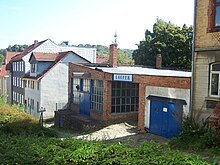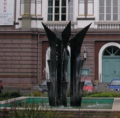Günther Laufer
Günther Laufer (born May 12, 1907 in Eisenach ; † July 13, 1992 there ) was a German blacksmith , restorer and metal sculptor .
Life
Günther Laufer was born in Eisenach in 1907 as the son of master blacksmith and locksmith Gustav Laufer. After attending secondary school, he completed an apprenticeship as a blacksmith in his parents' business on Frauenberg from 1922 to 1926 and from 1926 attended the Munich School of Applied Arts and the technical school in Roßwein , where he passed the master craftsman's examination. In his own words, the study of Bavarian blacksmithing of the Rococo in Munich, especially the Würzburg master blacksmith Johann Georg Oegg and the technology of the French school of Nancy, were formative for his artistic work . After working as an assistant at various contemporary metal sculptors in Berlin and Munich, where he had completed additional studies in steel construction at the Technical University of Munich , he became a teacher in the metal class at the school for master craftsmen in Weimar in 1934 .
After returning wounded from the Second World War , he took over his father's business in 1941, which he ran until it was nationalized in 1972. In 1967 he was appointed professor at the University of Industrial Design in Halle, Burg Giebichenstein . He was a founding member of the Association of Visual Artists of the GDR and its honorary chairman and chairman of the arts and crafts section of Thuringia.
Günther Laufer died on July 13, 1992 at the age of 85 in his hometown and found his final resting place in the main cemetery there . At the request of the SPD faction city council his grave in 2020 became the honorary grave declared the city of Eisenach.
Services, works
Günther Laufer was involved in the restoration of the Berlin State Opera in 1954/55 as an employee of Richard Paulick as one of the twelve most important blacksmiths in the GDR at the time. In addition to copying classic techniques as perfectly as possible, Laufer sought the artistic challenge of designing facades and public buildings, a trademark of his work was the use of waste products from the metalworking industry. In 1966 he created the altar wall of the Stephanuskirche in Weimar-Schöndorf from punching waste . In his hometown of Eisenach, many of his works can still be seen today, such as the dragon fountain on the Wartburg , the ornamental grilles at the city palace, the donkey fountain in the Goethegarten or the summer prize sculpture on Schiffsplatz. The fountain he created in 1970 on the Eisenacher Theaterplatz was dismantled in 2010 because it was dilapidated.
His works were shown at numerous exhibitions during his lifetime. a. 1963 in the Grassi-Museum Leipzig , 1977 on the occasion of his 70th birthday in the Wartburg and 1985 in the gallery at the Fischmarkt in Erfurt .
Summer profit sculpture in Eisenach
trademark
Günther Laufer marked the majority of his works with - GL - for Günther Laufer, but his father Gustav Laufer already used this sign , so it is difficult to clearly assign a work.
literature
- Urania Culture and Education Association Gotha e. V. (Ed.): Eisenach personalities. A biographical lexicon. RhinoVerlag, Weimar 2004, ISBN 3-932081-45-5 , p. 84 .
- Heinz Seidel: A master of handicrafts . In: Kulturbund, Kreisverband Eisenach (Ed.): Wartburg tower . Eisenach 1956, p. 8-11 .
- Literature by and about Günther Laufer in the catalog of the German National Library
Web links
Individual evidence
- ↑ Birgit Schellbach: Eisenacher Kunstschmied is honored . In: Thuringian General . May 26, 2020 ( online ).
- ^ The blacksmiths involved in the restoration (1954/55) of the state opera "Unter den Linden" in East Berlin. (No longer available online.) Baufachinformation.de, formerly in the original ; Retrieved March 13, 2009 . ( Page no longer available , search in web archives ) Info: The link was automatically marked as defective. Please check the link according to the instructions and then remove this notice.
- ^ Pastor Bernd Müller: History of Weimar-Schöndorf. (No longer available online.) Formerly in the original ; Retrieved March 13, 2009 . ( Page no longer available , search in web archives ) Info: The link was automatically marked as defective. Please check the link according to the instructions and then remove this notice.
- ↑ Fountain on Theaterplatz is being dismantled , accessed on September 12, 2014
| personal data | |
|---|---|
| SURNAME | Laufer, Günther |
| BRIEF DESCRIPTION | German blacksmith, restorer and metal sculptor |
| DATE OF BIRTH | May 12, 1907 |
| PLACE OF BIRTH | Eisenach |
| DATE OF DEATH | July 13, 1992 |
| Place of death | Eisenach |






